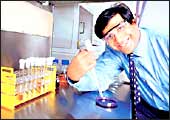 |
| The holy grail:
Saldanha (above) says Glenmark's goals are clear; it wants
to be a pure innovation company. It hopes to get six compounds
to launch stage by 2012 |
If it happens, it will be
sweet victory for Dr Reddy's Laboratories, and which is why it is
appropriate that India's first indigenous drug may be the one to
treat diabetes. "If all goes well with the phase III trials
of balaglitazone, then the earliest we can launch the drug would
be in 2010 or 2011. If not, then it could take another two years
(for the next),'' says G.V. Prasad, the company's Executive Vice
Chairman and CEO.
Balaglitazone, or DRF 2593, happens to be the most advanced
NCE (new chemical entity, or molecule) in the country, having
successfully completed phase II clinical trials. Dr Reddy's now
hopes to announce shortly the launch of phase III trials for this
molecule meant for the treatment of type 2 diabetes.
If it is balaglitazone or bala (as it is referred to internally)
for Dr Reddy's, it is oglemilast (GRC 3886) for Mumbai-based Glenmark
Pharmaceuticals. Currently in phase II trials, it will treat asthma
and Glenmark hopes to launch it by 2009/2010. That is not all.
By then, it hopes to get another lead to launch stage. This is
GRC 8200, a novel drug for type II diabetes that it recently out-licensed
to Merck kgaa.
There are other companies in pursuit of their own drugs. Pharma
major Ranbaxy, has a molecule, RBX 11160 (an anti-malarial) in
phase II clinical trials, Wockhardt has WCK 771 (a broad spectrum
antibiotic) also in phase II. Zydus Cadila has four new molecular
entities in development and this includes zyh1, a compound for
treating dyslipidemia (read: high cholesterol), which is also
undergoing phase II clinical evaluation. Similarly, Nicholas Piramal
India has a lead molecule in oncology (P 276) that belongs to
a novel class of anti-cancer agents called CDK 4 inhibitors. This
is undergoing phase I/II clinical trials in Canada and India.
The company also has two candidates in the inflammation space
and one in infectious diseases. The one in infectious diseases
is an anti-fungal herbal product in phase II clinical trials.
In fact, various analysts say that about 10 companies could be
pursuing any kind of serious NCE research and working in all with
some 40 NCE leads.
Analysts, however, point out that arguably the most aggressive
pursuers of NCEs are Dr Reddy's and Glenmark. The latter hopes
to get up to six compounds to the launch stage over the next five
years (by 2012). At the moment, these molecules are in various
stages of development, with the most advanced being GRC 3886 (oglemilast)-an
asthma and chronic obstructive pulmonary disease (COPD) molecule.
"Companies need to first define their goal and decide where
they want to be," says Glenn Saldanha, CEO, Glenmark. "A
few of our contemporaries have still not made that decision. We
are clear that we need to be a pure innovation company and our
generic business will only help fuel innovation,'' says Saldanha.
The company has heavily focussed on this in the past five years
and now on hopes to get one molecule every year into clinical
trials.
As for Dr Reddy's, it has a pipeline of nine NCEs, of which
five are in clinical development and four in pre-clinical stage.
Out of its portfolio, the company has assigned four NCEs to Perlecan
Pharma and one each is under a co-development arrangement with
Rheoscience A/S of Denmark (this is for DRF 2593, or bala) and
ClinTec International (this is for DRF 1042 in phase II, meant
for solid tumors). Other than these, Dr Reddy's plans to complement
the internal R&D efforts by pursuing, what it calls, "strategic
partnerships and alliances". "It has taken us 10 long
years to get to this stage. We licensed it (bala) out (to Novo
Nordisk) in 1997 (Novo exited the deal subsequently),'' says K.
Anji Reddy, Chairman, Dr Reddy's Labs.
In the last three years (fiscal 2004, 2005 and 2006), Dr Reddy's
spent Rs 73 crore, Rs 87 crore, and Rs 82 crore, respectively,
towards drug discovery activities. But what excites him, says
Reddy, is that some of their drugs could well change the way people
live-in particular, drugs relating to obesity and atherosclerosis
(fat deposits along artery walls). "It is time more Indian
companies realised that there is a window of opportunity-not many
Big Pharma companies are coming out with blockbusters," he
says. With some luck, companies like Dr Reddy's may soon earn
the innovator tag.
|





